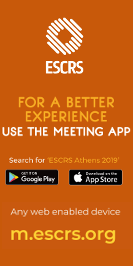Posters
(results will display both Free Papers & Poster)
Risk factors for early flap misalignment following microkeratome-assisted LASIK: a retrospective large database analysis
Poster Details
First Author: M.Mimouni ISRAEL
Co Author(s): A. Friehmann N. Assad G. Rabina O. Spierer A. Nemet I. Kaiserman
Abstract Details
Purpose:
To determine the factors associated with early flap misalignment following microkeratome assisted laser in situ keratomileusis (LASIK).
Setting:
Care-Vision Laser Centers, Tel-Aviv, Israel
Methods:
This large database retrospective study included the right eyes of consecutive LASIK cases performed between 2005 and 2016 at Care-Vision Laser Centers, Tel-Aviv, Israel. Patients were divided into 2 groups according to whether or not they subsequently developed early flap misalignment.
Results:
Overall 14,582 eyes (age 32.4±10.3 years) were included and early misalignment developed in 158 eyes (1.1%). In the misalignment group there was a higher rate of Moria M2 microkeratome use (rather than SBK) (55.2% versus 40.5%, respectively, p<0.001), more treatment during the spring (32.3% versus 22.8%, p=0.003) and in a higher operating room temperature (23.34±1.06 versus 22.98±1.26, p<0.001). In multivariable analysis, surgeon, year of surgery, high operating room temperature (OR=1.22, p=0.006), 9.0 mm treatment zone (as opposed to smaller zones, OR=1.54, p=0.04) and spring time (OR=1.58, p=0.02) were associated with flap misalignment.
Conclusions:
In the modern LASIK era, greater treatment zones, higher operating room temperature and operating during the spring were associated with increased flap misalignment rates. The association with operating room temperature and seasonal variation is of interest and merits further research.
Financial Disclosure:
None



